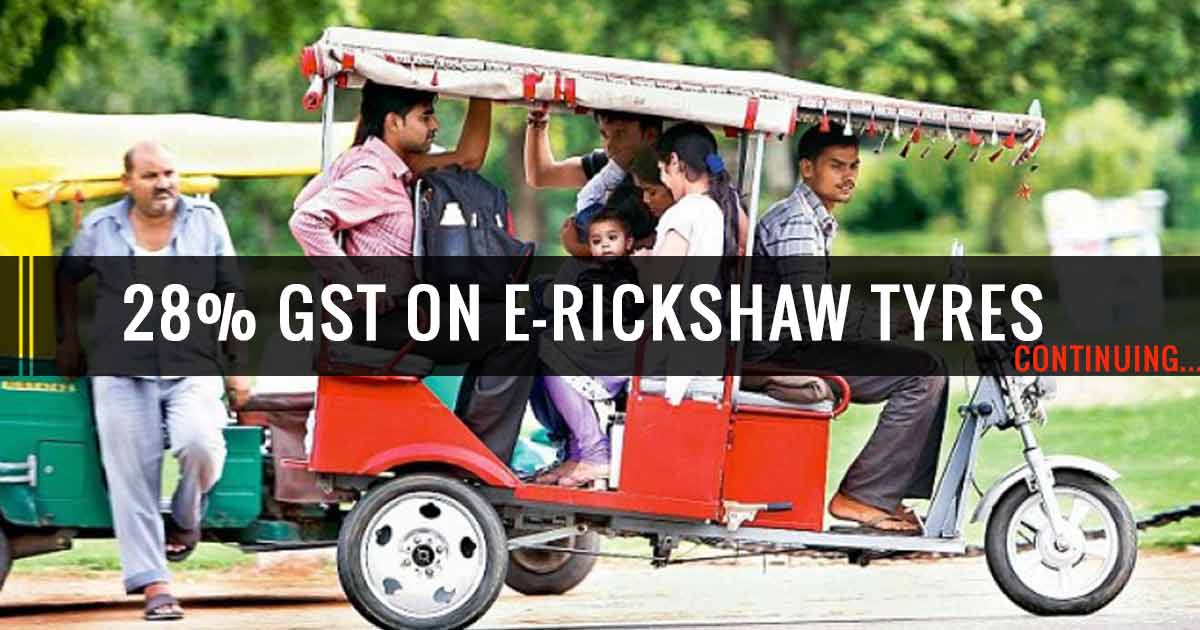Rejecting the application filed by CEAT, a leading tyre manufacturer in India, for reducing the GST rate on e-rickshaw tyres to 5%, the Maharashtra Authority for Advance Ruling (AAR) said that tyres used in e-rickshaws will continue to attract the top GST rate of 28%.
The applicant, CEAT, made the argument that the tyres of all other ‘three-wheeled powered cycle rickshaw‘ are under the 5% slab according to the GST tariff schedule, which doesn’t have a specific mention of the rates for e-rickshaw tyres, so the 5% rate should be meant for tyres of all ‘three-wheeled powered cycle rickshaw’ vehicles. The reason why CEAT had to file the appeal is that they have been charging 5% tax on tyres and tubes of all three-wheeler rickshaws, including e-rickshaw, as mentioned in the tariff schedule.
Since there was no clear communication about the GST rate on e-rickshaw tyres, operators have been enjoying a 5% GST until now. It is stated by some of the resources that the 28% GST is applicable due to the miscellaneous tax bracket of 5% on pedal rickshaws and 28% percent on non-pedal rickshaws.
The ruling would increase the cost for e-rickshaw operators, who now have to pay 28% GST with no way to utilise the ITC of the tax paid on tyres.
“Taxing e-rickshaw tyres at 28% against a rate of 5% which is notified for manual rickshaw tyres seems to be a little harsh and goes against the public policy. E-rickshaw pullers operate below the threshold limit for GST registration and thereby they would not be able to claim any input tax credit resulting into an additional tax of 23%, hitting their earnings directly,” said Rajat Mohan, partner, AMRG & Associates.
CIAT, in its application, argued that GST rate should be the same on like items. Since all types of ‘three-wheeled powered cycle rickshaw’ fall into the same category, the tax rate should also be the same at all. “Extending the same principle to e-rickshaws, it is submitted, that e-rickshaws should be treated as similar to ‘three-wheeled powered cycle rickshaws’ in law and clubbed with the same for the purpose of taxation under GST,” the application said.
The authority rejected the argument saying that e-rickshaws are fundamentally different from powered rickshaws. Whereas e-rickshaws can only be powered by an electric motor, a powered rickshaw can also be driven manually, if need be. Also, the size of tubes and tyres used in e-rickshaws is similar to that used in motorcycles and scooters.
Another difference, as mentioned by the authority, is that e-rickshaws are defined by ‘Motor Vehicle Act’ as a motor vehicle and require a registration with local transport authority, unlike powered rickshaws, which do not need a registration to operate.
Read Also: Step By Step Guide: GST Registration Online on Government GST Portal
“The product is classified and covered by Tariff Heading 4011 and the rate of tax shall be at the rate of 14% under MGST Act, 2017 and 14% under CGST Act, 2017,” the ruling said.
